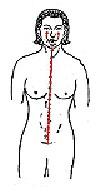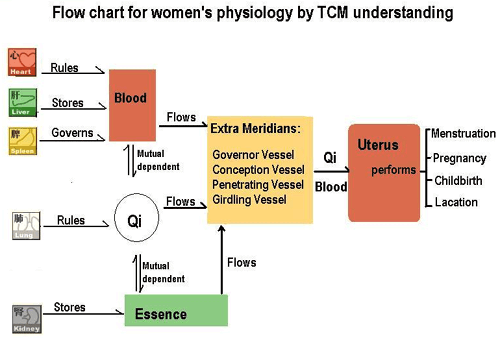TCM Understanding of Women's Physiology
Traditional Chinese medicine (TCM) understands the gender variation in physiology and disease development. During a clinical consultation, it is necessary for physicians to consider these differences and to pay attention to the characteristics of women's diseases.
Basically, the activities of organ system, meridian system, blood and qi (vital energy) circulations between men and women are similar, however women have special physiological structures like the breasts, uterus, cervix, and vagina that let them performing menstruation, pregnancy, childbirth and lactation. The female organs need abundant blood and qi supply to function properly. Internal organs are the source of blood and qi productions, meridians are the channels for blood and qi distributions. Therefore, the physiological functions of women rely on the promotional effects of the organs, meridians, blood and qi.
The Extra Eight Meridians
Normal physiological functioning also depends on the proper regulation of the standard nomenclatures of the eight meridians. Because the majority of uterine qi and blood travels within these meridians, the relationship between the uterus and the extra meridian network is extremely close.
The extra eight meridians include the Governor Vessel, Conception Vessel, Thoroughfare Vessel, Girdling Vessel, Yin Link Vessel, Yang Link Vessel, Yin Heel Vessel and Yang Heel Vessel. Unlike the twelve regular meridians, these eight vessels are not distributed regularly but are situated in a rather complex pattern among the regular meridians. Their main function is to strengthen the links between the twelve regular meridians and to regulate qi and blood circulation. They have special relationships with the liver, kidney, uterus, brain and marrow and thus influence these structures physiologically and pathologically. These vessels do not possess direct connections or interior-exterior relationships with the zang organs and fu organs.
- The Governor Vessel (du mai) originates from the perineum just before the anus, runs in the midline up along the spinal column and reaches the head finally. This meridian meets all the Yang meridians, thus is called the "sea of the yang meridians." It is responsible for governing the qi for all the yang meridians of the body. This vessel has close relationships with the brain, spinal cord and kidney respectively. Since it communicates with the brain, it can be regarded as a link similar to the pituitary-adrenal axis in Western medicine. In women, this vessel makes blood exit the body during menstruation.
- The Conception Vessel (ren mai) originates from the perineum, runs along the anterior midline of the abdomen, passes through the cheek and enters into the eye socket finally. It meets all the yin meridians, and thus is called the "sea of the yin meridians." It is responsible for receiving and bearing the qi of the yin meridians. In women, this meridian is thought to originate in the uterus where the fetus is nourished, thus there is a saying that "the Conception Vessel dominates the uterus and pregnancy." It provides yin substances for all women's physiological activities.
- The Thoroughfare Vessel (chong mai) originates in the pelvic cavity and runs alongside the kidney meridian up to the thorax. It is regarded as the “sea of blood," which is the place for the twelve regular meridians to converge and where it helps regulate the qi and blood inside them. This vessel influences the supply and proper movement of blood in the uterus, and is closely related to the menses. The main difference between the Thoroughfare Vessel and Conception Vessel in relation to menstruation is that the Conception Vessel controls qi and can be used to tonify and nourish, where as the Thoroughfare Vessel controls blood, and is used to move qi and blood and to remove obstructions.
- The Girdling Vessel (dai mai) originates below the rib side, runs down along the lateral side of loin and encircles the waist. It passes through the uterus like a girdle. The Girdling Vessel retains the meridians of the entire body, promoting their interconnected relationships. In women, it also takes charge of nourishing and lubricating the uterus and controls vaginal discharge.
 |
 |
 |
 |
| Governor Vessel | Conception Vessel | Thoroughfare Vessel | Girdling Vessel |
The Female Reproductive System in TCM
In TCM views, the uterus plays the major role in performing the physiological functions of female. The uterus, also called the "child's palace," lies in the lower abdomen, in the center of pelvic cavity, behind the urinary bladder and in front of the rectum. Its lower opening connects with the birth canal. The primary function of the uterus is to produce menses and to cultivate the fetus.
- Producing menses: menstruation is formed in the uterus. When a woman reaches puberty, her uterus matures and her kidney essence is enriched to a certain extent. The kidneys then will produce a type of substance for promoting sexual functions, which is called tian gui. Under the action of this substance, the Conception Vessel and Thoroughfare Vessel are exuberant and flushed with abundant qi and blood. The excessive qi and blood will empty into the uterus and produce regular menses. In old age, the kidney essence is exhausted and tian gui declines. The Conception Vessel and Thoroughfare Vessel gradually close and become obstructed. A woman then begins to have menstrual irregularities until menopause occurs.
- Cultivating the fetus: once a woman's uterus is fully developed, and her menses are regular. She has the ability to become pregnant and give birth. When an egg from her ovary is fertilized with a sperm, pregnancy will result. From a TCM understanding, this process involves the combination of congenital essences from both sexes, which are transmitted into the embryo in the uterus. Thereafter, the uterus supplies the nutrients for the growth and development of the fetus until childbirth.

The functions of the uterus are supported and coordinated by the heart, liver, spleen and kidneys as well as the Conception and Thoroughfare Vessels. This is because producing menses and cultivating a fetus rely on the nourishment of blood and promotion of the kidney essence. These nourishing substances are regulated and supplied by the following TCM concepts:
-
- The heart rules the blood.
- The liver stores the blood.
- The spleen governs the blood.
- The kidneys store essence.
- The Conception and Thoroughfare Vessels control qi and blood in the uterus.
Only when the organs and meridians function well can the uterus work normally. On the other hand, disorders in the above organs or meridians will affect the uterus, resulting in menstrual disorders and possibly fertility problems.
For the treatment of women disorders, physicians always focuses on invigorating these organs, and replenishing blood as well.
Note: From the foregoing physiology and pathology of the uterus, it can be seen that the uterus in TCM encompasses not only to the womb but also the whole internal genital system.


